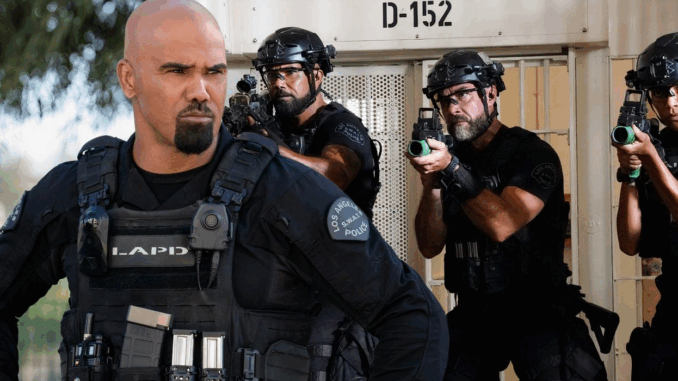
When Reality Check Comes to Prime Time—And It Explodes
Remember that dramatic S.W.A.T. episode where Sergeant Hondo casually sits down with a ticking bomb, identifies the “warm wire,” clamped it—and defused it? It looked exciting, but here’s the thing: a real ex‑Navy Special Ops bomb disposal technician—a former EOD operator with four deployments—watching that scene couldn’t help but cringe. In an interview highlighted by ScreenRant, the expert tore into the scene’s glaring inaccuracies, dropping gems like, “So yeah, we’re not going to be carrying around briefcases…sit down in it, arm it…and render it safe. Yeah…you wish.”discovery.com+2screenrant.com+2businessinsider.com+2businessinsider.com
The Bomb‑Defusing Scene That Backfired on S.W.A.T.
A Ticking Time-Bomb Drama…Or Not?
Onscreen, Hondo sits cross‑legged next to a bulky device with a visible timer, grooms through wires, and uh—clamps one random wire labeled “warm,” then pauses for a dramatic sigh. Close your eyes, click, fade to commercial, dramatic music. All fun TV stuff—but the realism? Gone.
What the Real Navy Tech Said
No Such Thing As the ‘Warm Wire’—It’s Hollywood Bull
The EOD vet pointed out that “there’s no ‘warm wire’ or color-coded wire trick” in real life. You could buy any colored wire from Home Depot. Bombs don’t come with labels.
No Heavy Toolkits—Light and Tight Is the Reality
Forget bulky kits hidden in briefcases; real EOD operators travel light, carrying minimal gear on their person during missions—no dramatic totes or backpacks.
The Myth of the Countdown Clock
The Big Timer Is Just for Show
That big-screen countdown? Fake. Most bombs rely on internal systems—not digital clocks. Realistically, you wouldn’t see a giant “5 minutes left” meter because the minute often counts down internally, not theatrically.
Why These Errors Actually Matter
Beyond Just Geek Gripes
Sure, it’s entertainment—but repeated inaccuracies shape public perception. This “CSI effect” leads real jurors and civilians to overestimate the speed and precision of forensic and bomb control work. screenrant.com
EOD Procedures Hollywood Ignores—And We Shouldn’t
Diagnosis Comes Before Disarmament
The expert mentioned you can’t just clamp and go. Before you cut a wire, you need diagnostics—resistance testing, device inspection, swelling check. No one casually clamps and walks away.
Roles of Robots, Gear, and Training
In real EOD ops—even military ones—you’d see robots, remote cameras, and tightly controlled staging. Sitting beside the bomb, hands-on, is last resort.
TV Editing vs. Battlefield Reality
Show Timing Must Bow to Real Timing
TV wants six‑minute scenes, from build‑up to victory sighs. In reality, even accessing the device, diagnosing it, and disarming could take hours or days, depending on complexity and safety protocols.
So Why Do Producers Keep It Flat Wrong?
Drama Over Details
Counting down, colored wires, time pressure—it sells tension. But tension built on false tech undermines credibility for those who know.
Viewers Eat It—Then Don’t Question It
Most viewers don’t know the procedures anyway. Hollywood delivers what feels dangerous—even if it’s inaccurately dangerous.
Other Boom Misfires on TV & Film
Hollywood vs. EOD Vet Ratings
Ex‑Navy vet Jay Ly has reviewed bomb scenes in The Hurt Locker, Mission: Impossible, Speed, and S.W.A.T. and gives most a thumbs down for realism. screenrant.comscreenrant.com+2businessinsider.com+2discovery.com+2
What Real Bomb Disposal Looks Like
Slow, Methodical, Remote
EOD techs often work using remote systems—robots, x‑rays—avoiding proximity. Each wire is tested; each inch of the device is handled like a mini‑crime scene.
Why This Matters for the Genre
H3: When Accuracy Builds Trust
Accurate depictions build stronger tension. When audiences trust characters, they care more. When they see flat lies, the disconnect happens—even subconsciously.
Can S.W.A.T. Fix This Without Losing Drama?
Yes—With Smart Writing
They can keep the thrills and rev the pace but drop the big timer, add robotics expertise, multiple tests, layered protocols—and maybe a line about “protocol says no immediate clamp job.”
The Bigger Picture—Impact Beyond Entertainment
Public understanding of EOD work shapes recruitment, policy, and budget discussions.
Unrealistic portrayals stroke myth—not respect—for operators risking their lives.
Takeaways for TV Writers
-
Consult with real EOD experts.
-
Ditch the “warm wire” myth.
-
Use remote/disruptive render-safe techniques realistically.
-
Highlight teamwork and layered safety protocols.
Conclusion: Don’t Defuse the Truth
Dramatic bomb scenes grab attention. But mixing up reality with Hollywood spectacle does real damage—to credibility, to viewer understanding, and to the legacy of operatives like the ex‑Navy EOD tech who called it out. Shows like S.W.A.T.should be entertaining—but also respectful of real expertise.
FAQs
1. Why did an ex‑Navy tech criticize S.W.A.T.’s bomb scene?
Because it ignored real-world EOD procedures—oversimplifying critical steps, tools, and protocols.screenrant.combusinessinsider.com
2. Is the “warm wire” trick fake?
Yes! In real bomb disarmament, wires aren’t color-coded or “warm”; operators test resistance and use diagnostics instead.
3. What do real EOD pros actually use?
Robotic tools, remote disruptors, x-ray backpacks, and rigorous diagnostics—rarely getting close to bombs until absolutely safe.
4. Does inaccurate portrayal in TV affect real-world views?
Definitely. The “CSI effect” shows how fictional accuracy can shape jury beliefs. Exaggerated bomb scenes may oversell risk control.
5. Can S.W.A.T. still be exciting without fake tropes?
Absolutely. By using real protocols, layered tension, and character stakes, shows can be compelling and credible.

